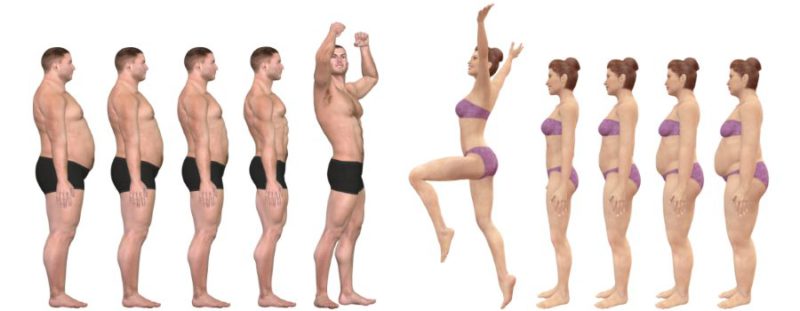Body Fat. We all want to burn it off and send it packing. Not that body fat doesn’t have its place but in excess, it clogs things up, squeezes important organs, and pretty much gives us an express ticket to low self-confidence, illness, and at worst an early out from this world to the next. Of course, not all body fat is bad and is, in fact, a natural and ESSENTIAL element to our physiology.
Which, of course, brings us to body fat percentage- that mystical number where sub 12% for guys and 20-ish% for the ladies gets you to “Hey… I look like that Guy/Girl in that magazine” land. Still, unless you’ve got a reference… numbers are just numbers. Percentages can be a little tough to visualize- you’re not alone if you’ve ever wondered what an ideal body fat percentage looks like.
Let’s look at some basics of Body Fat
Body Fat Percentage – is the amount of body fat (lb, or kg) divided by total body weight listed as a percentage. For example, a 170 lb man with 30lb of body fat has a body fat percentage of 16 %(30/180).
Body Fat Distribution – We all have different body fat distributions, or how fat is distributed across our body. For example, some women may have very little body fat on their abs, but a lot on their thighs and triceps, while others will have the opposite. The same thing goes with men, but most men carry fat in their stomachs. I tried my best to show pictures that highlighted the stomach region for men and the hips/thighs/stomach region for women.
Body Shape -Similar to body fat distribution is we all have different body shapes, so two different body shapes may have the same body fat percentage even if they don’t look like it. A classic example is a skinny runway model may have the same body fat percentage as a fit, athletic woman.
Age – Most body fat measurement devices will reflect higher body fat levels as age increases. For example, a 20-year-old man and a 50-year-old man may have the same subcutaneous body fat measurement (fat under the skin), but the 20-year-old maybe 15% and the 50-year-old will be at 20%. As we age, fat around the organs (visceral) and within a muscle (intramuscular) tends to increase and most formulas take this into account.
Muscle Striations – As an individual becomes more defined, the actual muscle can be seen more clearly, which looks like thin rods, referred to as striations.
Vascularity – This is the appearance of veins in different areas of the body as body fat decreases.
Body Fat Percentage Chart
The American Council on Exercise (ACE)* determined average fat percentages differ according to different categories and specific groups. To get an idea of where your fat percentage may lie:
| Description | Women | Men |
| Essential Fat | 10-13% | 2-5% |
| Athletes | 14-20% | 6-12% |
| Fitness | 21-24% | 13-16% |
| Average | 25-30% | 17-21% |
| Overweight | 31-39% | 22-29% |
| Obese | 40% + | 30% + |
What are the methods of measuring body fat percentage?
There are quite a few methods of measuring body fat; the most common methods are the following (in order of probable accuracy)
- Dual-energy X-ray absorptiometry (DEXA Scan)
- Hydrostatic Testing (Underwater Density Test)
- Air Displacement Plethysmograph (BOD POD)
- SCULPT Device – Great way to measure and track progress.
- Skinfold Measurement (Skin Pinch with Calipers – only recommended when done by a professional)
- Navy Fat Method – THIS IS ONE OF THE BEST FOR AN “AT HOME” WAY TO ESTIMATE BF% AND PROGRESS.
- Bioelectrical impedance analysis (Handheld/Scale device)
- Height and circumference methods (Measurement Collections)
As mentioned above, a great and somewhat reliable (for most body shapes) ways to estimate BF% and review progress over time, is the NAVY FAT method, which is estimated with just a tape measure.
This is an easy and great way to estimate both a starting point and subsequent progress over time. When we look at the error factors of these methods, we see pictures can be used as much as anything else.
Why Is Body Fat Percentage Important?
The lower your body fat percentage is, the leaner you are. The higher your body fat percentage, the fatter you are. After a certain threshold (around 25-30% body fat for men, 30-35% for women), it starts to become unhealthy.
If your goal is to get lean, tracking body fat percentage over time provides valuable data that you can use to reach your goal faster.
Tracking body fat is better than tracking only your body weight. Why? Because losing, let’s say, 20 lbs of body weight does not necessarily mean you lost 20 lbs of body fat. Some of that weight loss could be from water, muscle glycogen, and/or muscle tissue. And it should go without saying that you want to keep as much muscle as possible.
Similarly, if you’re trying to bulk up and build muscle, you shouldn’t just track your body weight. If you gain weight for the sake of seeing the number on the scale go up, you’re bound to put on an excessive amount of body fat. Tracking your body fat in addition to body weight will help to minimize fat gains as you bulk.
What is the minimum body fat percentage for human beings?
There is currently no definitive answer for what is essential body fat. Looking at research though we assume a range of 5% for men and 12% for women is landing in the essential range. For hormonal and reproductive reasons women need to store a higher level of body fat than men. It is thought that 15% is the lowest range a woman should maintain. There is some argument about this, but technically the data isn’t there to conclude if it is body fat or lifestyle/training habits that cause problems. In my personal opinion, I think women should lightly trying to maintain body fat levels below 15%.
In recent years body fat percentage is being considered a better and more popular way to view health markers of individuals over the traditional, and largely inaccurate, BMI index.
Body Fat Percentage of Men
-
3-4% body fat:
Ridiculously lean. Many bodybuilders drop to a body fat percentage of about 3-4% when they are preparing for competitions. At this level of body fat, the muscles, veins, and striations (the rod looking stripes on a muscle) is very visible. This is a very low level and the lowest level of body fat you should have. Two percent of body fat is the barest essential minimum needed for organs to properly function
-
6-7% body fat:
This level isn’t as extreme as the competition bodybuilder level. However, this level is still very difficult to maintain and not easily sustainable. This level is characterized by muscle definition in most muscle groups and some clear vascularity (the showing of your veins) in areas such as arms, legs, and abs.
- 10-12% body fat: This level of body fat is a sustainable level for men. Your abs can be seen, but aren’t as chiseled or defined as a man with 6-7% body fat. This is the body fat percentage that is the perfect beach body most people strive for. At this level there are still some defined veins in the arms and legs, but not as visible as fewer percentages.
- 15% body fat: This percentage of body fat usually fits into the “lean and fit” category. Outlines of muscle can be seen, but there is not really clear separation between them. Muscles and veins can slightly be seen, but are covered by a thin layer of fat. However, the overall body shape is present and can be noticed.
- 20% body fat: Muscle definition is not as present and noticeable especially in the abdomen. A man with this level of body fat typically has a “soft” look and has a pouch on his abdomen.
-
25% body fat:
There is almost no separation of muscles, no noticeable veins, and no muscle striations. The man’s waist begins to increase and he may have a little neck fat. However, this man may not look like he has 25% body fat in normal clothing BUT… over 25% body fat for a man is considered obese, and men are creeping into the over a 40inch waist, which is considered abdominal obesity.
- 30% body fat: More fat is present around the body at the 30% level including waist, back, thighs, and calves. The waist will appear slightly larger relative to the hips, and the man’s stomach will most-likely be protruding noticeably over the waist.
-
35% body fat:
As men get heavier, their fat tends to go right to their stomach or gut. This percentage of body fat is more of the beer gut look. The waist circumference at this point can be about 40+ inches.
- 40% body fat: This percentage is very similar to the 35% level, yet there is more fat accumulation in the stomach and waist region. This is the point where basic daily activities become difficult such as walking up stairs or bending over to pick something up. At this body fat percentage, you are considered morbidly obese.
Body Fat Percentage of Women
-
10-12% Body fat
: This percentage is the lowest a woman should be. At this percentage the women’s vascularity and striations are visible. However, the striations are not as clearly visible. The woman’s muscles are clearly separated. At this point, you may be wondering why women’s body fat is higher than a man’s. The reason is that women have more fat in beat tissues and surrounding the uterus. This level of body fat isn’t necessarily considered safe or healthy for women who menstruate.
-
15-17% body fat:
At this level, muscles are still visible. Abs, legs, and arms have a definition. There is some separation between muscles and there is also some vascularity. Women don’t have as much curvature in hips and buttocks because of the low body fat level. This is a common level of body fat among fitness models. Many women who are at this level may not be able to menstruate.
-
20-22% body fat:
This is the “fit” category of the majority of the body fat charts. Also, this level is the most common among female athletes. The woman has some definition in the abs and there is a small amount of body fat on the arms and the legs, but it isn’t too visible.
- 25% body fat: This percentage is on the lower end of what is average for women. At this level, you are neither too slim nor overweight. ABs and other muscles are not as apparent at this level, and there is generally more fat around the hips and buttocks areas.
- 30% body fat: The pictures at the 25% and 30% level don’t show too much of a difference, however at this level, there is more accumulation of fat in the hips and buttocks region. 30% of body fat is considered a high average for women.
-
35% body fat:
This level is considered overweight. The body has more fat accumulations and the face and neck begin to appear fuller and more round. Belly fat is also more pronounced at this level as well.
-
40% body fat:
At this level, a woman is considered obese. This means there is not a very balanced muscle to fat ratio. Some women may not look like they have 40% body fat, but their muscle mass is lower, which brings their percentage to 40%.
- 45% body fat: At this bodyweight, the hips become noticeably wider than the shoulders. The general hip circumference may reach 45+ inches and waist circumference 35+ inches. The skin may start to lose its smooth nature at this percentage level.
- 50% body fat: This skin will appear more dimple or “cottage cheese” like. Hip Circumference may reach 45+ inches and waist circumference 40+ inches.
With the help of these pictures, we now know where we stand visually and can calculate how much body fat we need to reduce in order to achieve a certain body fat percentage. One kilogram of body fat provides about 7000 calories. Of course, we can not just save 7000 calories, and then lose one kilogram of body fat. No, that\’s not so easy, because the body has other sources of energy at its disposal. In addition, the body reacts relatively quickly with a calorie reduction with countermeasures and reduces the metabolism by reducing the thermogenesis, for example. This results in the more effective use of energy for muscle work, thereby burning fewer calories.
Therefore, the diet strategy must be chosen intelligently. For example, with the help of nutrition timing, we can control our bodies to reduce body fat as much as possible without slowing down the metabolism.
Takeaway
Eating healthy and eating within a calorie limit is important when trying to maintain a certain body fat percentage. Also, resistance exercises and cardiovascular exercises are important in maintaining or achieving a good body fat percentage, according to ACE. Estimation of body fat percentage using comparison images is a simple way to approximate.
To lose weight, transforming yourself into a healthier version, and maintaining the weight, subscribe to Keto India for a personalized keto consultation. Good luck on your weight loss journey! Stay tuned for more such health content! Also, don\’t forget to follow us on Instagram for the daily dose of Ketogenic Diet, Health, and Wellness!










